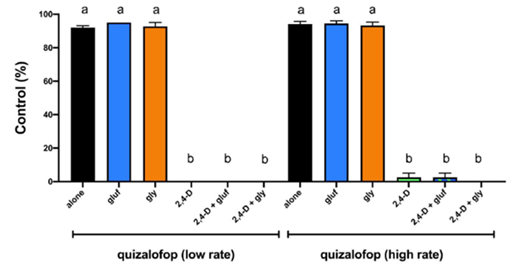
Growing soybeans this year? Protect your yield from volunteer corn

As crop genetics and trait platforms change, so must herbicide strategies. When it comes to soybeans, there’s a specific need to evolve how grassy weeds like volunteer corn are controlled. That’s why many growers are adopting ARROW ALL IN®. No matter what soybeans you grow, this high-performance herbicide provides optimal control thanks to our advanced formulation technology. And in 2025, it’s needed more than ever.
This growing season many seed suppliers will be offering Enlist E3™ soybeans, which will be able to be treated with Enlist herbicide (2,4-D choline). And while Enlist herbicide is a powerful option for broadleaf weed control, antagonism issues with graminicides (herbicides that treat grassy weeds) can arise.
Historically, graminicides containing quizalofop-P-ethyl (‘fop’ products) have been utilized for grassy weed control (particularly volunteer corn) in soybean fields. However, when combined with Enlist herbicide, ‘fop’ products become largely ineffective. To overcome this issue growers should consider using a graminicide containing clethodim (‘dim’ products) – such as ARROW ALL IN®.
As seen below, Purdue University found that regardless of ‘fop’ rates, the antagonism with Enlist herbicide (the only 2,4-D product registered for over-the-top use in Enlist E3™ soybeans) essentially negates the graminicide’s activity when treating volunteer corn.
Meanwhile, ‘dim’ products were still successful at controlling volunteer corn when used with Enlist herbicide:
Although the ‘dim’ products demonstrated strong results in this study, these solutions still face the risk of reduced effectiveness due to antagonism. Your level of coverage depends on factors like the product you choose and how you use it.
Best practices for using ARROW ALL IN® with Enlist E3™ soybeans
Maximize your ‘dim’ graminicide's effectiveness in three simple ways:
Condition your spray water with ammonium sulfate (AMS)
Water quality can affect herbicide performance, and clethodim is no exception. In areas with high levels of bicarbonates, like those with limestone-rich water sources, clethodim's effectiveness can be reduced. Adding AMS to your spray mix helps neutralize the bicarbonates, improving clethodim uptake and maximizing its efficacy.
Use higher rates of clethodim
When mixing a ‘dim’ product with Enlist herbicide, using a higher rate of clethodim is recommended to counteract any antagonism. While lower rates may work when targeting volunteer corn alone, there are recommendations out of the US that using a 1.5X rate (still within the labelled range) can help ensure commercially acceptable control when Enlist herbicide is in the mix.
Ensure proper use of surfactants
‘Dim’ products can be harder for weeds to absorb compared to other graminicides. Surfactants help with uptake and help slow breakdown from sunlight before the herbicide is fully absorbed. ARROW ALL IN® includes a built-in surfactant, which saves you time and promotes quick uptake for optimal performance in your spray mix.
Stay one step ahead of volunteer corn
New corn genetics and herbicide tolerance traits are exciting, but consideration must also be given to volunteer plants the following season. Hybrids from the new PowerCore Enlist Corn package are tolerant to Enlist herbicide, glyphosate, glufosinate, and the ‘fop’ graminicides. This also means these products won’t provide effective control on any volunteer corn that may emerge the next year.
Fortunately, ARROW ALL IN®, a ‘dim’ graminicide, is an effective option for controlling PowerCore Enlist volunteer corn. In fact, with its flexible tank-mix options and superior formulation, ARROW ALL IN® is a top choice for controlling volunteer corn regardless of the genetic platform.
To learn more about preventing volunteer corn from hurting your soybean yields, visit the ARROW ALL IN® product page. You can also explore other solutions for soybean crop protection here. When you want to defend your soybeans, ADAMA has the answers.


